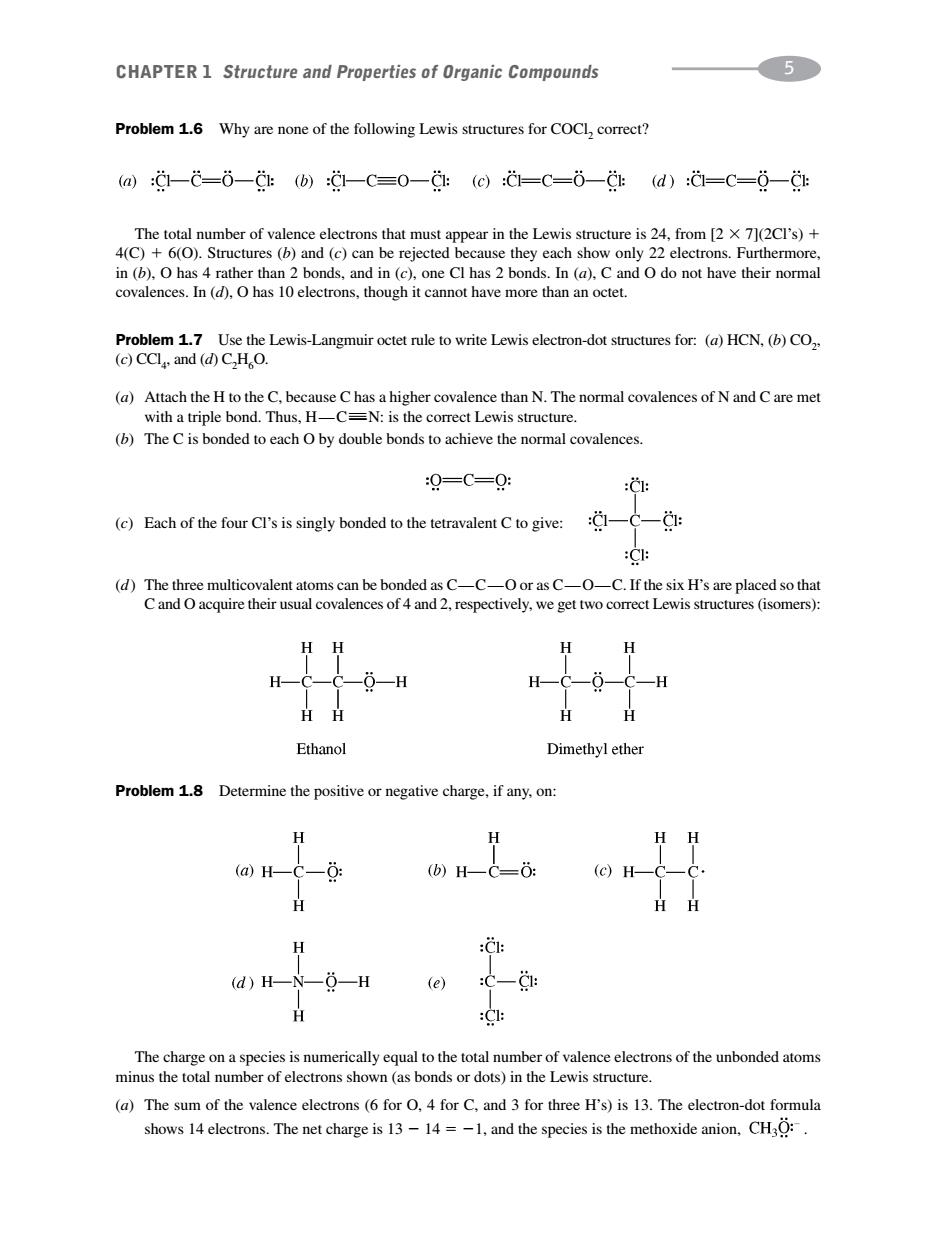正在加载图片...

CHAPTER 1 Structure and Properties of Organic Compounds Problem 16 Why are none of the following Lewis structures for COClcorrect? @:g-c-0-0:(b):g-C=0-a:(c:C=C=6-年(d):C=C=0-a: The total number of valence electrons that must ar in the Lewis structure is 24.from 12 x 71(2CI's)+ 4(C)+6().Structures()and (c)can be rejected because they each show only 2 electrons.Furthermore in(b).O has 4 rather than 2 bonds,and in (c),one Cl has 2 bonds.In (a).C and O do not have their normal covalences.In (d),O has 10 electrons,though it cannot have more than an octet. Problem 17 Use the Lewis-Langmuir octet rule to write Lewis electron-dot structures for:(a)HCN,(b)CO (e)CCl.and (d)C.H,O. (a)Attach the H to the C.bec than N.The normal covalences of Nand Care me with a triple is the correct Lew s structure (b)The Cis bonded to eachby double bonds to achieve the normal covalences 0=C=Q: (c)Each of the four Cl'sis singly bonded to the tetravalent Cto give: (d) of 4 and 2.respectively. e get two c Ethanol Dimethyl ether Problem 1.8 Determine the positive or negative charge,if any,on: (a)H-C-: (d)H-N--H (e) -: The charge on a species is numerically equal to the total number of valence electrons of the unbonded atoms minus the total number of electrons shown (as bonds or dots)in the Lewis structure. (a)The sum of the valence electrons(6 for O.4 for C.and 3 for three H's)is 13.The electron-dot formula shows 14 electrons.The net charge is 13-14=-1,and the species is the methoxide anion,CH3O:Problem 1.6 Why are none of the following Lewis structures for COCl2 correct? CHAPTER 1 Structure and Properties of Organic Compounds 5 (c) Each of the four Cl’s is singly bonded to the tetravalent C to give: (d) The three multicovalent atoms can be bonded as C—C—O or as C—O—C. If the six H’s are placed so that C and O acquire their usual covalences of 4 and 2, respectively, we get two correct Lewis structures (isomers): The total number of valence electrons that must appear in the Lewis structure is 24, from [2 7](2Cl’s) 4(C) 6(O). Structures (b) and (c) can be rejected because they each show only 22 electrons. Furthermore, in (b), O has 4 rather than 2 bonds, and in (c), one Cl has 2 bonds. In (a), C and O do not have their normal covalences. In (d), O has 10 electrons, though it cannot have more than an octet. Problem 1.7 Use the Lewis-Langmuir octet rule to write Lewis electron-dot structures for: (a) HCN, (b) CO2 , (c) CCl4 , and (d) C2 H6 O. (a) Attach the H to the C, because C has a higher covalence than N. The normal covalences of N and C are met with a triple bond. Thus, H—C ⎯N: is the correct Lewis structure. (b) The C is bonded to each O by double bonds to achieve the normal covalences. Problem 1.8 Determine the positive or negative charge, if any, on: The charge on a species is numerically equal to the total number of valence electrons of the unbonded atoms minus the total number of electrons shown (as bonds or dots) in the Lewis structure. (a) The sum of the valence electrons (6 for O, 4 for C, and 3 for three H’s) is 13. The electron-dot formula shows 14 electrons. The net charge is 13 14 1, and the species is the methoxide anion, .����